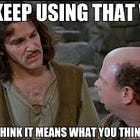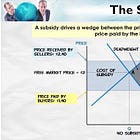Anatomy of Market Failure I: Pigou and Polluter Pays
All models are wrong, but some are useful. -George Box
As I suggested last time, the claim of "market failure" is common in lots of applied economics, including energy and environmental economics.
Market failure is used to support arguments for taxes or subsidies to “correct” some types of market failures, such as the production and investment tax credits for investments in wind and solar energy that I discussed recently. One rationale for these subsidies is that the environmental benefits of those technologies are not incorporated into existing market designs and thus will not be reflected in market prices.
The economic theory underlying the market failure concept is extensive, with some important contributions I'll highlight over the next few weeks from A.C. Pigou, James Buchanan, Ronald Coase, and Elinor Ostrom. One of my favorite papers on this topic, one that I used when I taught environmental economics, is Bruce Yandle's Coase, Pigou, and Environmental Rights (in P.J. Hill and Roger Meiners, eds., Who Owns the Environment? Rowman & Littlefield 1998). Bruce is outstanding at using folksy, relatable stories to communicate important economic concepts (he is, after all, the originator of the Bootleggers and Baptists public choice model of special interest coalition formation). In this paper he grounds the economics of market failure and externality in his local childhood paper mill. Inspired by Bruce, let's use this stylized example to flesh out the economics of market failure and externality (which I also did in my 2021 book in the Fraser Institute's Essential Scholar series, The Essential Ronald Coase).
Historic Fox River Mills, Appleton, Wisconsin. By Royalbroil - Own work, CC BY-SA 3.0, https://commons.wikimedia.org/w/index.php?curid=9818431
Imagine a town with a river, where the town has a paper mill and a water bottling company. The paper mill produces and sells paper to consumers. Their production process generates waste, and as a profit-maximizing firm with fiduciary duties to its owners, the firm’s managers look for ways to reduce waste management costs along with other costs. If they can discharge the waste in the river with no financial cost, they have an incentive to do so, because their market is competitive and they have several rivals, so they have an incentive to minimize their costs. But this discharge imposes a cost on the water bottling company by increasing the amount of filtration they have to do; this cost of the paper transaction is borne by the water company, which is not a party to the paper transaction. This is the problem of social cost: a problem of interdependence and third-party spillovers.
The starting point is the benchmark model of "perfect competition". Codified in theory in the 1920s, overused as a straw man ever since, this model laid out the foundational economic principle that markets tend to self-organization and self-correction. In its most extreme and extremely simplified form, the perfectly competitive model states that in a setting with stable consumer preferences and producer costs, a market for a homogeneous good that has many participants will maximize the total possible gains from trade/surplus/welfare and leave no waste – all resources will be in their highest-value uses. This highly stylized model provides the welfare comparison – full efficiency, maximized welfare, no gains from trade left on the table – for economics to this day, including the problem of social cost and externality.
Although analysis of this issue was not new in the 20th century, it was the English economist A.C. Pigou who developed the neoclassical approach to such third-party costs and benefits that we now refer to as externalities in his book The Economics of Welfare (1920 (4th edition 1932)). This work was an enormously influential codification of neoclassical economics building on Alfred Marshall's pathbreaking Principles of Economics (1890). In Part II Chapter IX Pigou addresses "divergences between marginal social net product and marginal private net product," building on Marshall's "external economies" concept. His cases of third-party effects include "... resources devoted to the prevention of smoke from factory chimneys: for this smoke in large towns inflicts a heavy uncharged loss on the community, in injury to buildings and vegetables, expenses for washing clothes and cleaning rooms, expenses for the provision of extra artificial light, and in many other ways." (1920(1932), p. 184) The problem of social cost is that
... self-interest will tend to bring about equality in the values of the marginal private net products of resources invested in different ways. But it will not tend to bring about equality in the values of the marginal social net products except when marginal private net product and marginal social net product are identical. When there is a divergence between these two ... certain specific acts of interference with normal economic processes may be expected, not to diminish, but to increase the dividend. (1920(1932), p. 172)
When marginal private value and marginal social value diverge, Pigou argues that government intervention can improve efficiency and increase welfare ("the dividend"), whereas usually government intervention through a tax or subsidy is wasteful and creates inefficiency measured as deadweight loss. Pigou’s analysis thus suggested that internalizing such costs and benefits should be done using taxes and subsidies.
For example, the paper mill should have to pay a tax equal to the amount of financial harm their waste generates for the water company. This “polluter pays” principle, an example of the concept of producer responsibility, is now common in regulatory approaches to externalities. The economic logic underlying producer responsibility is an assumption that the producer is the party that is most likely to be able to take actions (such as changing production levels or investing in different technology) to mitigate the cost or harm. An implication of that logic is that this party should be responsible for any penalties, or to pay the tax in a Pigouvian tax mechanism; they should also be entitled to benefits that arise from their actions (although they will never be able to capture all of the benefits as most of the benefits take the form of dispersed environmental improvement available to all parties).
As suggested by my favorite George Box quote above, the Pigouvian externality model is wrong, and I would argue it has been misused when people don't bear in mind its limitations. As with other neoclassical models, it is institutionally sterile, devoid of any attention to the legal, social, and cultural contexts in which market exchange occurs. Those contexts certainly influence the terms on which market transactions occur and the frequency, magnitude, and incidence of third-party effects. In its simplest form it doesn't account for enforcement costs, a problem that Pigou discusses but often gets overlooked in environmental policy debates. Its epistemic assumptions are large, assuming that the "optimal" tax or subsidy is knowable and measurable when regulators have no way of knowing the optimal Pigouvian tax or subsidy. As Yandle suggested,
... the politician must have an estimate of the amount of damage imposed on people downstream. Estimating damage in the absence of market-generated information is no simple matter. For example, what if a person downstream can take actions to avoid the harm of dirty water by moving to another location at a cost of $5,000, yet the estimate of damage without taking offsetting action is $10,000? It is the $5,000 damage that should be relevant to the policy maker, not the $10,000. But the $10,000 estimate is easier to obtain than the $5,000 estimate. If the tax is based on $10,000, the paper mill and its customers will pay more than the social cost of producing paper. The river will be too clean.
The situation becomes even more complicated when there are many receivers of waste, and each one assigns a different level of harm to the water pollution. As the scale of control increases, information cost rises exponentially. (1998, p. 128)
Similarly, William Baumol noted in an underappreciated paper on Pigouvian taxation (On Taxation and the Control of Externalities, 1972) that
Despite the validity in principle of the tax-subsidy approach of the Pigouvian tradition, in practice it suffers from serious difficulties. For we do not know how to estimate the magnitudes of the social costs, the data needed to implement the Pigouvian tax-subsidy proposals. For example, a very substantial portion of the cost of pollution is psychic; and even if we knew how to evaluate the psychic cost to some one individual we seem to have little hope of dealing with effects so widely diffused through the population.
The Pigouvian model is also grounded in the same assumptions as the perfect competition model that serves as its benchmark, that consumer preferences and producer costs are stable and knowable. All of these assumptions fail in application to actual policy. It's also flawed because of its one-sided “polluter pays” framing of the problem of social cost, which can bias the legal/regulatory approach away from discovering the least-cost way to deal with the problem (more on that when we get to Coase ...).
But the Pigouvian model is useful at a conceptual level even if it isn't a strong basis for policy. It systematized how economists characterize third-party effects in exchange situations. It leads us to ask important questions like “are all of the benefits and costs captured in this analysis?” As a piece of economic theory it is a useful companion to the perfect competition benchmark, as long as you don't take either model literally or too seriously. I suspect Pigou would have agreed with that, at least in part, given how much his descriptions use the “tend to” construction; he knew he was engaging in pure theory, and it was an important, seminal contribution to the development of economic theory.
I'll give the last word to Yandle:
[Pigou], like many later economists, performed the analysis in an institutional vacuum.
We should not be overly critical of Pigou for focusing so closely on analysis and so little on existing institutions. Failure by economists to focus on the rich role played by institutions is not uncommon, even today. Pigou's work was done in the tradition of early twentieth century neoclassical economists. Adam Smith's fascination with the realities of the market had long since been forgotten. The neoclassical economists were much like builders of increasingly complex and ornate clocks who seldom asked if their clocks could tell (predict) time. Portraying problems in the abstract terms of the differential calculus was, at the margin, considered more important than discovering the way the world worked. (1998. pp. 126-127)
Next: What if externalities are subjective and not objective, and what if they don't change peoples' decisions?





Excellent piece and most of all the writing has the kind of clarity that is so lacking in economics academia.